The Jefferson Nickel is a testament to its worth and timeless design. There are strike- and condition-rarities that receive premium pay, especially those with Full Step designation.
But today, we’re focusing on the value of 1962 Jefferson Nickel through detailed price charts. Additionally, we collated valuable error coins, so remember to check that out!
1962 Jefferson Nickel Value: Mint Location and Condition
The 1962 Nickel is a pre-war composition coin with 75% copper and 25% nickel. With this metal combination, there is no question that the circulated condition is barely higher than its face value.
However, there are some noteworthy 1962 Jefferson Nicklel in uncirculated condition, which sell at a premium. But let’s look at the summary chart before going deeper into it.
| Grade | 1962 Nickel Philadelphia Mint | 1962 Nickel Denver Mint |
| Circulated | $0.10-$0.20 | $0.10-$0.20 |
| MS-60 | $0.25-$0.35 | $0.25-$0.35 |
| MS-65 | $12.50-$20 | $42.50-$60 |
| MS-66 | $40-$65 | $100-$180 |
| MS-67 | $325 | $500 |
| Proof | $10-$75 | No proof coins |
The 1962 Nickel History
After the Buffalo Nickel reached its 25th year of production, the coin was replaced with a great figure from America—Thomas Jefferson. With his lasting legacy, the decree to place him in a nickel is truly fitting. So, in 1938, the Treasury Department held a public competition to scout a worthy design for the five-cent.
There are two specific rules to join the competition. One is that the obverse side should showcase the “authentic portrait” of President Thomas Jefferson. Second, the reverse side should depict Monticello, the 3rd U.S. president’s historic home.
It was open to anyone as long as it passed the conditions and the Mint’s technical requirements. With over 390 designs submitted, Felix Schlag bagged the $1,000 cash prize in April 1938. The Federal Commission of Fine Arts further recommended a few changes to polish the design before commencing production in September 1938.
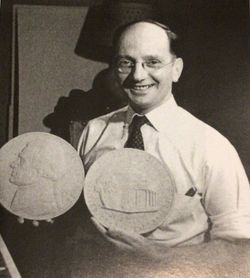
The original copper-nickel composition went on through the years. However, at the onset of World War II, Congress decided to remove the Nickel component from the five-cent coin as the armories needed high use of it.
The Mint produced it with 56% copper, 35% silver, and 9% manganese instead. But despite the changes, these “war nickels” seemed satisfactory in production and circulation until the mid-1960s.
Philadelphia and Denver minted 380,797,739 Jefferson Nickels—creating three varieties. With massive mintage, it also became a common coin in circulation, although some are still popular with collectors.
| Mint Location | Coin Specification | Mintage |
| Philadelphia | 1962 Nickel No Mint Mark | 97,384,000 |
| Philadelphia | 1962 Nickel No Mint Mark, Proof | 3,218,019 |
| Denver | 1962-D Nickel | 280,195,720 |
| Total | – | 380,797,739 |
Price Guide For The 1962 Jefferson Nickel
In this section, we will discuss the value of the circulation strike 1962 Jefferson Nickels, including the proof strike version.
1962-P Jefferson Nickel Value

A 1962-P Jefferson Nickel has no mint mark but is highly lustrous and almost proof-like. However, the nickel has deficient strike characteristics with low-quality center relief because of the retired proof dies used during minting.
Today, a 1962-P nickel with an MS-60 grade is considered common, with 220,000 examples. But those with MS-65 grade and above are less common, with only 90,000 appearances.
With the market value, a circulated 1962-P Jefferson Nickel is worth $0.10 to $0.20. But an uncirculated condition can reach $0.25 to $325. While it’s already worth the price, it still can fetch hundreds to thousands if it gains a Full Step (FS) designation. According to NGC, a 1962 Nickel with FS details offers a premium price of $30 to $4,000.
| 1962-P Jefferson Nickel Full Step Value Guide | ||||
| MS 64 | MS 65 | MS 66 | MS 67 | |
| MS 6 FS | $30-$40 | $60-$75 | $450-$500 | – |
| MS 5 FS | $20-$25 | $35-$55 | $325-$900 | $4,000 |
A 1962-P FS Nickel is scarce, with a survival estimate of 70,000 for grade 65 and above. With its low population, many collectors showed interest and bid high for this variety. An example is the 1962 MS-67+ FS, sold at a tremendous $21,150 and $9,600 by Heritage Auctions and Stack’s Bowers, respectively.
But it’s not only the MS-67 that made rounds in the auction history. A 1962 MS-66 was sold at a striking $1,955 and $1,208 by Bowers & Merena and Heritage Auctions, respectively.
Historical Prices: 1962-P Jefferson Nickel
The circulated condition for a 1962-P nickel started at a base price of $0.05 until October 2022. But it increased to $0.10 the following month and remained unchanged until today.
On the other hand, an uncirculated condition 1962-P nickel has inconsistent prices in the past five years. In the first quarter of 2019, it was worth $0.18, then increased by $0.20 in 2020. However—during the pandemic—it dropped to $0.15 until the last quarter of 2022. A 1962-P uncirculated nickel only increased to $0.25 as 2023 entered.
1962-D Jefferson Nickel Value
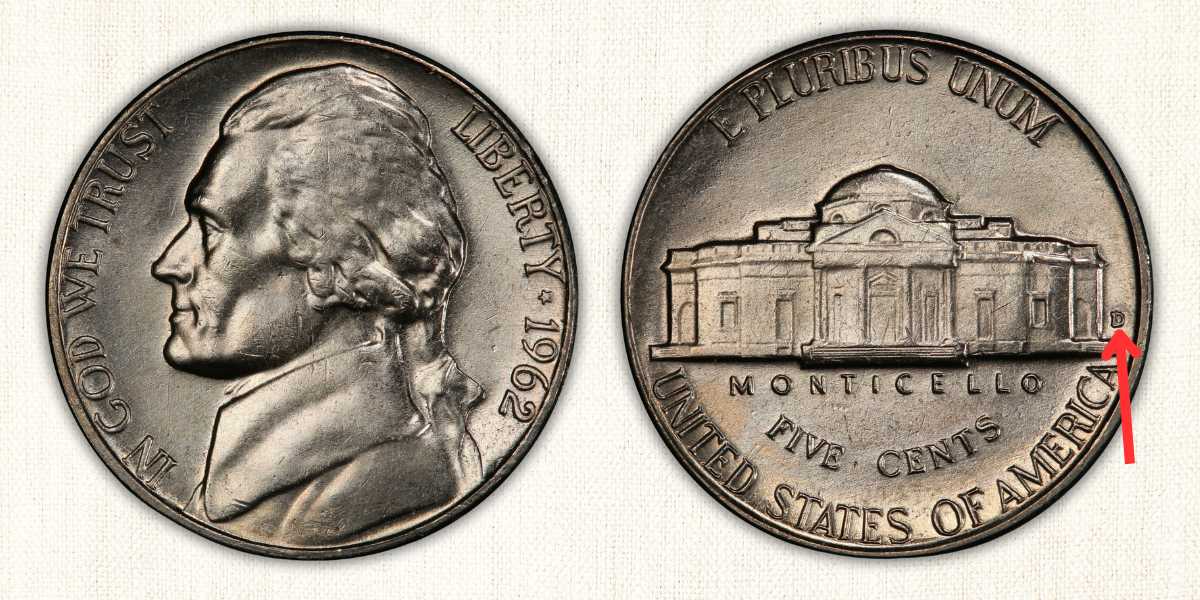
Unlike the Philadelphia Mint with only faint elements, the 1962 Denver-produced nickels have poor quality overall. They used worn-out dies, and the strikes were of subpar grade. Rough fields are visible, and the luster is not at its best.
But despite the coin’s condition, it is still considered valuable because of its low population estimate. According to PCGS, a 1962-D MS60 and above is considered scarce, with only 30,000 recorded examples. Meanwhile, a 1962-D MS65 and above is labeled rare, with only 400 known specimens.
Today, a circulated condition 1962-D Jefferson Nickel is worth $0.10 to $0.20, while an uncirculated condition can be worth $0.25 to $500.
Let’s look at its price if it features a Full Step.
| 1962-D Jefferson Nickel Full Step Value Guide | ||||
| MS 63 | MS 64 | MS 65 | MS 66 | |
| MS 6 FS | $425-$460 | $1,100-$1,200 | $450-$500 | $1,600-$1,650 |
| MS 5 FS | $120-$175 | $315-$500 | $850-$975 | $1,300 |
Since it is rare, a 1962-D FS can reach $425 to $1,650. But with its auction history, only a few records bore a thousand value since MS-66 is the highest grade available for this variety. The holding record is at $3,525 for an MS-65 Full Step.
Surprisingly, it has a semi-proof-like reflection, which is unexpected from the low-grade quality production of Denver in 1962. An MS-66 also follows close with an auction sale value of $1,500 by Heritage Auctions.
Historical Prices: 1962-D Jefferson Nickel
The 1962-D MS-65 Jefferson Nickel is worth $60 in the first quarter of 2019. But it continued to go downhill to $45 in the second quarter until the last quarter of 2020. Then, from 2021 to 2023, it remained unchanged at $42.50.
While these prices declined throughout the year, many collectors still regard this variety as valuable (as seen on the highest record history mentioned a while ago).
Note: The historical prices of a 1962-D circulated do not differ from the Philadelphia Mint.
1962 (P) Proof Jefferson Nickel Value

The Philadelphia Mint produced over 3 million of this variety, making it enough to satisfy many coin collector’s demands. Most grades are also labeled common—and some—can be acquired at minimal cost. However, those in MS–65 and above are less common, with only 120,000 known samples.
| Coin Condition | 1962 Nickel PF Cameo | 1962 Nickel PF Ultra Cameo |
| PF-64 | $15-$17.50 | $20-$22.50 |
| PF-65 | $20-$22.50 | $25-$27.50 |
| PF-66 | $25-$27.50 | $30-$35 |
| PF-67 | $30-$35 | $45-$55 |
| PF-68 | $40-$60 | $100-$150 |
| PF-69 | $175 | $550 |
Proof coins generally have sharply struck Full Steps on the Monticello, making it even more valuable. The 1962 Proof Nickel can sell for $10 to $75, while those displaying cameo contrast can reach $15 to $550.
According to PCGS Auction, three records reached a thousand value for a 1962 Proof Jefferson Nickel.
- PR-69 DCAM sold at $1,650 in 2022.
- PR-69 sold at $1,093 in 2007.
- PR-69 DCAM sold at $1,020 in 2020.
While most are grade PR-69, PCGS also recorded a PR-70 Deep Cameo. But it only sold for $115 in an Auction in 2007—making it also the highest sale record for that particular grade.
Historical Prices: 1962 Proof Jefferson Nickel
There are no uniform increments or decrements each year for this variety. Some grades may increase a year later, while others go full circle or retain their previous price.
| Proof | 2019 | 2021 | 2023 |
| PF-64 | $9 | $10 | $15 |
| PF-65 | $19 | $15 | $20 |
| PF-66 | $25 | $20 | $25 |
| PF-67 | $30 | $35 | $30 |
| PF-68 | $45 | $45 | $40 |
| PF-69 | $160 | $160 | $175 |
The supply and demand for each coin grade determine how much a 1962 Proof nickel is worth yearly. These prices change based on the average retail prices from the numismatic community, like their transactions and auctions.
For example, a 1962 PF69 continually rises in price since collectors still seek this specific grade and variety. Another reason is its auction record for the past years. If a certain coin has a strong collector base, you can expect it to gain more value.
How to Grade a Jefferson Nickel
Grading a 1962 Jefferson Nickel is similar to those Type 1 Series of nickel coins. You have to see if it is:
- Well-maintained,
- Has good quality of manufacture and appearance (strike characteristics),
- And if there are any unique mint errors.
All coins are judged based on condition before being given a specific grade. Aside from this, it can also earn a designation like Full Steps (FS) if it supplies the 5 or 6 steps requirement in the Monticello.
With uncirculated conditions, it is expected to render a higher value. However, dramatic error coins can also sell at a premium depending on the mint state and rarity.
1962 Jefferson Nickel Error Available On The Market
With high mintage, it is inevitable not to produce an error coin. Some may not seem visible and sell at a minimum price, while others may leave a unique element on the coin, elevating its value. Now, let’s see the different error types in a 1962 Jefferson Nickel and know how much they are worth today.
1962 Nickel Split Planchet Error
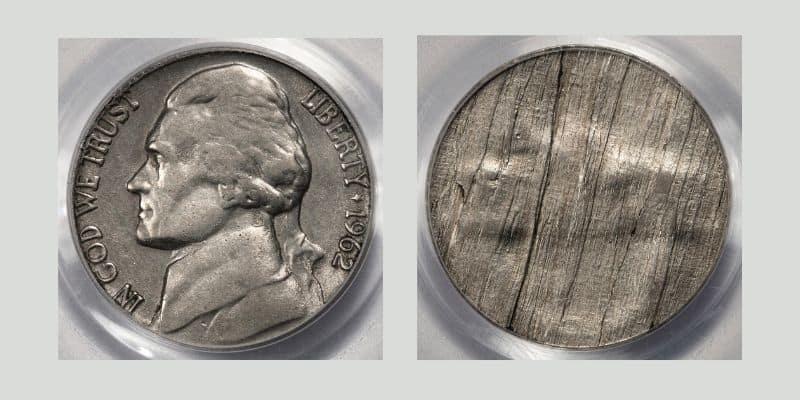
A split planchet error usually occurs on solid alloy coins—like cents and nickels. It can be due to internal laminations or poor outer-core layer adhesion. Coins struck with this issue may also result in less than the original weight.
With the design, some coins show apparent striates with faint elements, while others have 100% removed details on one side. This type of error is worth $40 to $70 but can fetch more if the split error percentage is high.
1962 Nickel Double Die (Obverse-Reverse) Error
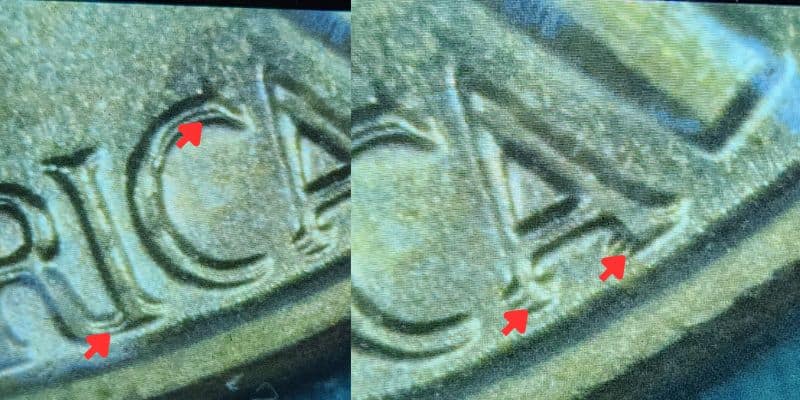
Doubled die error coins have either a full or partial image doubling. It can appear on the obverse side or the reverse side. Aside from this, it can also be classified into eight types.
But among all, the Class 1 or Rotated Error is the favorite of numismatists. This specific double die shows a misaligned direction of the elements, either clockwise or counterclockwise. It can cost around $15 in average condition but can go higher if in uncirculated mint condition.
1962 Nickel Repunched Mint Mark
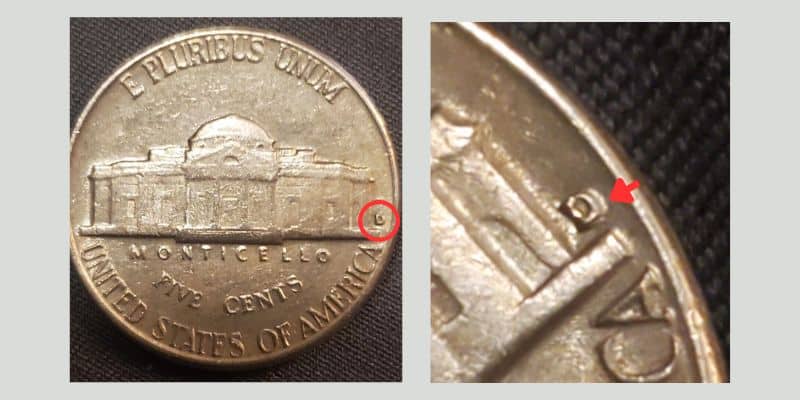
Repunched mint mark errors differ from double die errors as the former occurs during the normal minting process, not during the hobbing process.
To confirm if it is an RPM, check the surrounding edges and the inside hole for raised metals. If there are unnecessary details, you can ensure that it is re-punched. This type of error may value around $5 to $15.
1962 Nickel Lamination Cracks (Planchet Error)
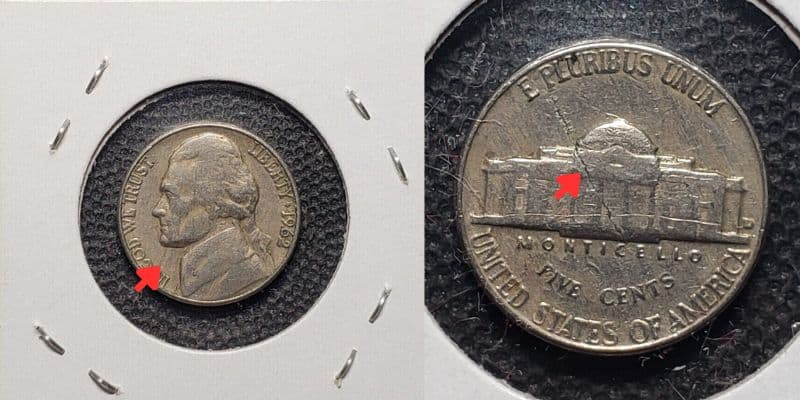
Lamination errors—or delamination errors—are easy to spot. It features a pertinent crack on the coin surface due to metal contamination. Compared to split planchets, the breaks are superficial and cause a lift on one side. Circulated lamination error coins only sell for a few dollars, but a dramatic lamination crack can fetch hundreds.
1962 Nickel Struck On Copper Cent Error
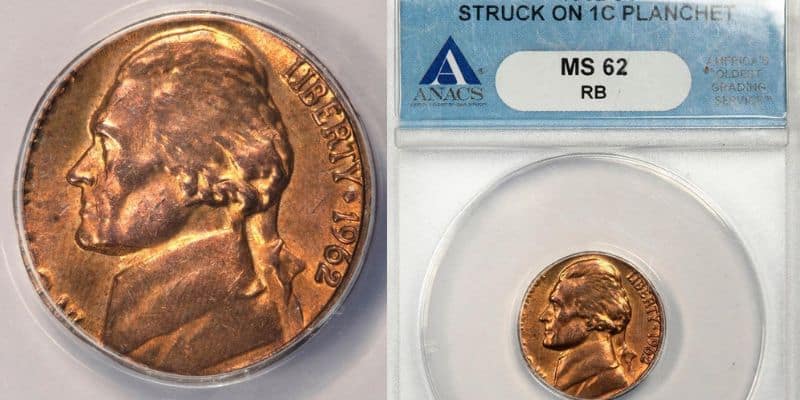
Struck on the wrong planchet coins is a unique error worth valuable money. It happens when one coin denomination planchet gets fed into a coin press issued with dies from another denomination. With that said, many also gave it a moniker of “double denomination.” This type of error can sell for around $100 to $600, depending on the coin’s condition.

Jenson is a professional numismatist, a dedicated coin collector, a graduate of the College of Business at Oregon State, a life member of the American Numismatic Association (ANA), and an overall coin nerd. He is the founder of Coin Value List.
